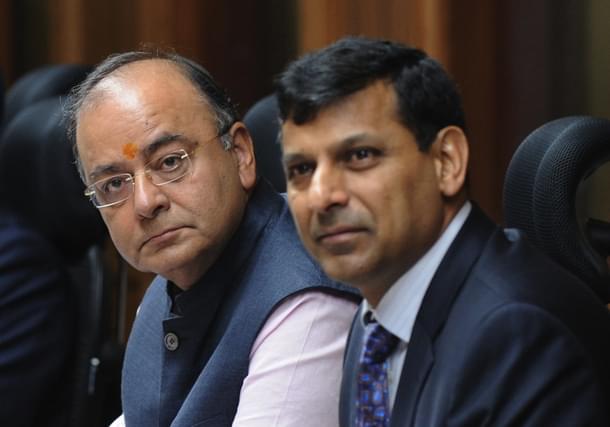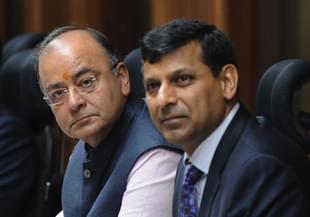Economy
Is Revenue-Led Fiscal Consolidation Possible in 2016-17?
Pinaki Chakraborty
Mar 01, 2016, 05:09 PM | Updated 05:09 PM IST
Save & read from anywhere!
Bookmark stories for easy access on any device or the Swarajya app.


Budget 2016-17 has committed itself to remain on the path of fiscal consolidation. How will this be achieved?
Let us look at the numbers for 2015-16. Fiscal consolidation in the current year has so far been revenue-led. Increased revenue mobilization through higher excise duty on crude oil prices played the trick. If we compare revised and budget estimate numbers of 2015-16, the excise duty bonanza is more than Rs. 54,000 crore. In the budget estimates (BE) for 2016-17, the excise duty collection is estimated to be Rs 3,18,670 crore. When compared with 2015-16 BE numbers, this means a growth of more than 38 per cent.
On the expenditure side, total expenditure in the revised estimates (RE) of 2015-16 is a ally higher than the 2015-16 BE figures. The estimated tax-to-GDP ratio for 2016-17(BE) is 10.8, while the expenditure to GDP ratio is 13.1 per cent. Thus, fiscal prudence in 2016-17 hinges on revenue mobilization, particularly higher excise duty collection.
This raises important questions about the sustainability of such a policy of sticky upward petroleum taxation accompanied by a decline in crude prices. A repeat of 2015-16 on a year-on-year basis is not possible. It can work only so long as crude prices remain benign. However, the fiscal headroom we see for 2015-16 cannot be taken for granted. Higher indirect tax collection resulted in the improvement in the tax-GDP ratio from 9.9 per cent in 2014-15 to 10.8 per cent in 2015-16 (RE). Direct tax collection declined in absolute terms by more than Rs 45,000 crore between the budget and revised estimates of 2015-16. Service tax collection also shows only a marginal improvement if we compare the 2015-16 budget and revised estimates.
Despite a 7.6 per cent real growth of the economy, decline in the direct tax collection by a wide margin from the budget estimates of 2015-16 and marginal improvement in service tax collection is puzzling. A part of this puzzle could be explained by the difference between real and nominal GDP growth rate. The advance estimates of GDP for 2015-16 shows nominal GDP growth rate at 8.6 per cent, which is much lower than the 11.5 per cent assumed in the beginning of the financial year. Since budget is at current prices, nominal numbers of tax collection may be depressed due to lower nominal GDP growth rate.
In 2016-17, the government is expected to have a fiscal deficit of 3.5 per cent of GDP and revenue deficit of 2.3 per cent of GDP. In absolute terms, the fiscal deficit is estimated to be Rs. 5,33,904 crore and revenue deficit is estimated to be Rs. 3,54,015 crore. If inflationary pressure is benign and nominal GDP growth rate is lower than the 11 per cent assumed in Budget 2016-17, the government may not be able to adhere to the deficit targets as a percentage of GDP even if the targets are met in absolute terms - an issue that became relevant for 2015-16 as well.
It needs to be highlighted that there is nothing sacrosanct about a fixed numerical fiscal deficit target since sustainable deficit over a cycle could be different than a fixed numerical limit. In a dynamic context, movement of fiscal deficit depends on the growth of GDP for two reasons: (a) change in GDP and (b) revenue and expenditure changes due to changes in GDP growth. Probably, keeping this in mind, the Finance Minister announced the setting up of a committee to review the implementation of Fiscal Responsibility and Budget Management (FRBM) Act.
In the Indian federal system, there is no way fiscal prudence can be achieved by the Centre alone when, under the FRBM Act, both Centre and states have almost equal borrowing limits. It is important for the committee to look into the aggregate borrowing by the Centre and states. The committee should look at drawing upon international experiences to suggest how the fiscal deficit can be adjusted over the growth cycle. Since macro-stabilization is a central function, a professional review of the FRBM Act may be able to provide informed policy choices to both the Centre and the states in order to take prudent policy decisions in times of crisis as well as boom.
Pinaki Chakraborty is a professor at the National Institute of Public Finance and Policy and was economic adviser to the Fourteenth Finance Commission





